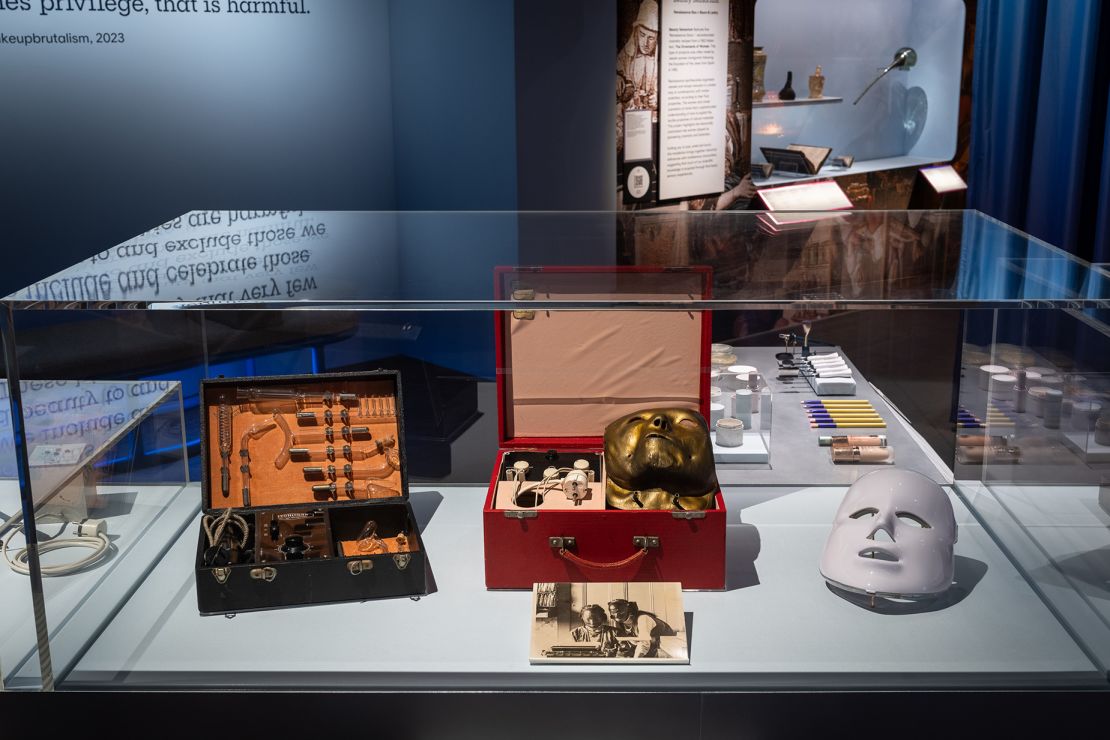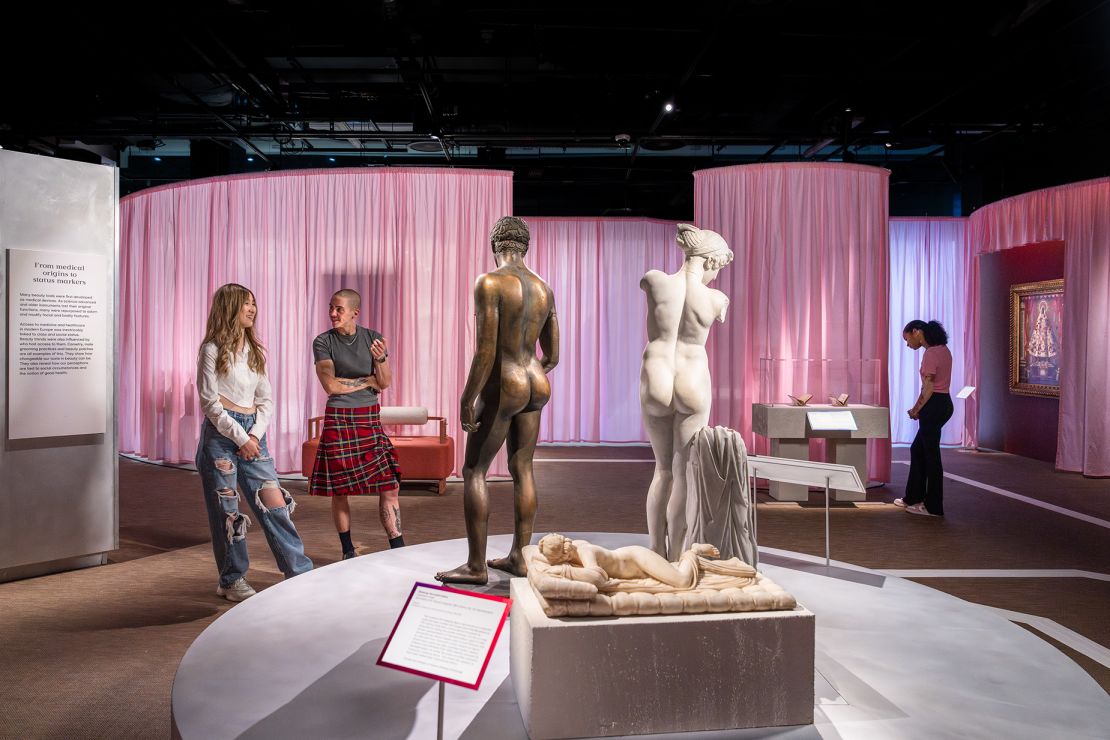What do a 17th-century European woman and an image-conscious Gen Z-er have in common? For one, both might choose to adorn a blemish mark with a star-shaped sticker.
In the 17th and 18th centuries, women (and sometimes men) bought beauty patches to cover smallpox, syphilis scars, or simply accentuate their pale skin. Today, they’re sold in drugstores across the world to “shrink and shield” acne.
According to “The Cult of Beauty,” a new exhibition at London’s Wellcome Collection museum, many contemporary skincare regimes and the beautifying practices of yore are far more similar than we realize. And the show’s curators have cleverly arranged over 200 intriguing items to demonstrate how.
Inside a glass display case, a 2018 red-light therapy “photon” face mask — an at-home treatment that still feels futuristic — sits next to its terrifying predecessor from 1950s Germany. Elsewhere, two jars of foundation, made 2,000 years apart, employ precisely the same marketing strategy: a beautiful woman’s visage etched on the lid. A 1920s hand-held “Punkt-Roller” (a German stomach roller designed to accentuate ab muscles) is paired with an upper-arm cellulite blitzer from 2000s Japan. “It shows how much has changed — and not changed,” curator Janice Li told CNN during a tour of the exhibition.

Li’s thesis reflects the exhibition’s overarching message: that the pursuit of beauty is innately human. By chronicling a wide range of artefacts, the oldest of which date back to Ancient Egypt, it hopes?to reframe our perceptions of beauty — from a new-age, vain or superficial phenomenon to something anthropological, historical and inescapable. “We want to take away the labels of ‘frivolous and secondary,’” said Li. “(Beauty) is something we do every day. It’s primary and essential.”
Of course, industry attitudes towards beauty and femininity have shifted dramatically in recent decades. Haunting objects, such as a 1950s “maternity” corset, created to support — and perhaps more importantly, conceal — a baby bump, for example, or a miniature girdle for a Victorian infant, are morbidly fascinating. A “Miss World” board game from 1972 sees players lose points for being “too fat” or having tattoos.
A life-size Barbie doll on display, meanwhile, is bang on trend — though this version stands in stark contrast to Greta Gerwig’s feminist blockbuster. The scaled-up figurine was created by mannequin designer Adel Rootstein in 2009 using Mattel’s original measurements. The doll’s body (including a near-impossible 21-inch waist) is so disproportionate it requires support from steel mounts to stay upright.

But who is this all for? After all, chasing beauty and youth — an instinctive impulse, the show suggests — often ends in disappointment, delusion, sometimes even death. Take, for instance, Diane de Poitiers, who very likely died from drinking liquid gold for its purported rejuvenating and anti-inflammatory properties. An 1841 lithograph of the French noblewoman hangs near the exhibition’s entrance alongside a 24-carat gold facial serum on sale today — a poignant reminder to anyone tempted to mock De Poitiers’ fate.
The exhibition proposes refreshing answers to time-honored beauty industry questions. For those who believe hair and makeup exist purely for the male gaze, a? 2009 image of the Brazilian prison beauty pageant “Miss Penetencaria,” taken by photographer Zed Nelson inside an all-female facility in Rio, suggests otherwise. Similarly, research from racial social history academic and author Emma Dabiri speaks to the idea that beauty’s obsession with whiteness came long before Western colonialism. A restored replica of a 7th-century sculpture of a Greek goddess shows her dark hair, painted face and, crucially, white skin. “It was an ideal that was pursued for a long time,” said Li, pointing to a 16th-century Chinese recipe for skin-whitening pearl powder. “This goes back to the association with status. In an agricultural society, as in Chinese culture (at the time), if you were an upper-class lady, you didn’t get out of the house.”

While Li and her colleagues take an unblinking look at what is now a $625-billion industry (the exhibition’s crescendo is another Nelson photo gruesome photo of a patient undergoing a facelift) the show is more a measured celebration than a scathing criticism. A wall of magazine “firsts” — including the first US Vogue cover to feature a Black woman, model Beverly Johnson, who fronted the August 1974 issue, and this year’s Vogue Philippines cover starring an 106-year-old woman, the first centenarian to front any edition of the fashion magazine?— are a paper-trail of progress.
So too is a section of the show loaned by the nearby Museum of Transology, an institution dedicated to documenting transgender, non-binary and intersex issues. An array of seemingly mundane cosmetic products from the museum’s collection each come with a touching handwritten memory from their anonymous owner: The first lipstick given to the subject by their sister, in a small gesture of acceptance; the long brown weave hastily grabbed by a victim of intolerance as they were kicked out of the family home, a solitary piece of armor seeking to protect its wearer against gendered violence. Each item reminds visitors of the sometimes essential value of beauty.
“It’s human nature,” said Li. “And it’s serious work.”
